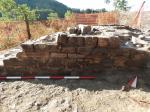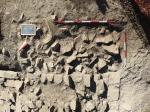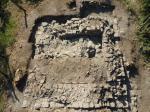Summary (English)
Based on the results obtained during the previous campaign, work continued on the evaluation of the archaeological deposit, concentrating attention on the highest part of the site that is the steep-sided low hill delimited to the east by sheer rock faces riding above the Dolo torrent.
The strategic position, together with bumps in the terrain suggested the presence of at least one buried structure. For this reason, it was decided to investigate the summit area by opening a 40 m2 trench in order to evaluate the quality and nature of the archaeological deposit.The excavations exposed the remains of a square tower 5.80 m wide, with walls c.120 cm wide, enclosing an internal space of c. 21 m2. The structure was built on a part of the site where there was no previous occupation. This part of the hill is quite narrow and characterised by an irregular rocky outcrop that was cut by the foundation trenches for the walls. The tower’s floor surface was created by levelling the natural substratum with a layer of beaten earth; several fragments of opus signinum suggest this material was used for at least one of the floors in the tower. Comparison with similar medieval standing structures makes it possible to propose a three-floored tower, with a raised entrance on the first floor. Based on the construction technique and finds, the tower was probably in use between the 12th and 13th centuries.
The tower was abandoned and deliberately demolished within a relatively short period. From a practical point of view, this must have been carried out from the inside, removing materials that could be reused, and throwing the unusable material outside. This demolition can be dated to the 14th century, or early 15th century at the latest, as indicated by the finds from the various demolition layers.
- Nicola Mancassola - Università degli Studi di Bologna
Director
Team
- Federico Zoni - Alma Mater Studiorum, Università di Bologna, Dipartimento di Storia Culture Civiltà
Research Body
- Alma Mater Studiorum, Università di Bologna
Funding Body
- Comune di Toano (RE)
- L’antica Fabbriceria onlus






![Download [PDF]](/excavation/skins/fasti/images/results/download_sml.png)

